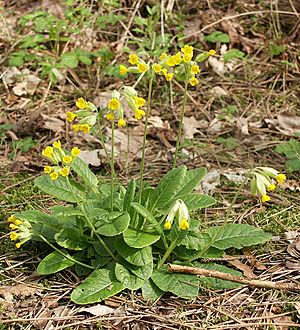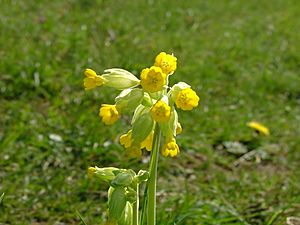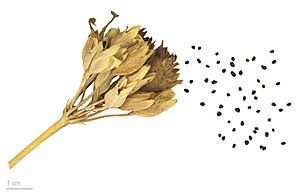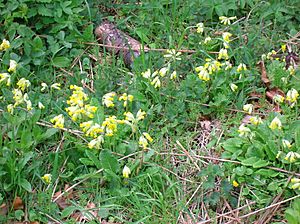Cowslip facts for kids
Quick facts for kids Cowslip |
|
|---|---|
 |
|
| Scientific classification | |
| Genus: |
Primula
|
| Species: |
veris
|
| Subspecies | |
|
Primula veris subsp. macrocalyx |
|
The Primula veris, also known as the cowslip, is a lovely flowering plant. It's a type of perennial plant, which means it lives for more than two years. You can find cowslips growing naturally across most of Europe and western Asia. They are part of the Primulaceae family, which includes other primroses. Sometimes, cowslips can mix with other Primula plants, like Primula vulgaris, to create new kinds of hybrid flowers.
Contents
What's in a Name?
The common name cowslip might sound a bit funny! One idea is that it comes from old English words meaning "cow dung." This makes sense because you often find these plants growing in fields where cows graze. Another idea is that it refers to "slippery" or "boggy" ground, which is also a common place for cowslips to grow.
The scientific name veris comes from Latin and means "of spring." This refers to the season when the flowers bloom. However, another primrose, P. vulgaris, actually flowers even earlier, sometimes as early as December in the British Isles!
Throughout history, cowslips have had many other interesting names. Some of these include "key flower," "fairy cups," and "palsywort."
How to Spot a Cowslip

The cowslip is a perennial plant that can grow up to 25 centimeters (about 10 inches) tall. It has a group of leaves at its base, like a rosette, which are usually 5–15 cm long.
In spring, you'll see bright deep yellow flowers. These flowers grow in clusters of 10 to 30 blooms on a single stem. Each flower is about 9–15 millimeters wide. Very rarely, you might even spot cowslips with red or orange flowers! This can happen when they cross-pollinate with other colorful primrose plants nearby.
Where Cowslips Grow
Cowslips love open spaces like fields, meadows, and even along coastal dunes and clifftops. In Britain, the number of cowslips went down in the 1970s and 1980s because of changes in farming.
However, they are making a comeback! Their seeds are now often included in wildflower mixes used to plant along roadsides and other large construction areas. This means you can sometimes see huge groups of cowslips growing together, which is helping them thrive again.
This plant is also popular in gardens and has won an award called the Royal Horticultural Society's Award of Garden Merit for being a great garden plant.
Cowslips in the Kitchen
Cowslip leaves have been used in cooking for a long time, especially in Spain where they are eaten as a salad green. In England, people traditionally used the flowers to flavor country wine and vinegars. They were also sugared to make a sweet treat or added to salads.
The juice from cowslips was even used to help prepare a dish called tansy for frying. The primrose (Primula vulgaris), which is a close relative of the cowslip, has similar uses in cooking. Its flowers were also used to add color to desserts.
The children's writer Alison Uttley wrote about cowslips in her story "The Country Child" (1931). She described how a young girl helped make cowslip wine on her family's farm. This special wine was served to important visitors and was considered more valuable than other homemade wines.
Myths and Old Stories
Cowslips have a long history in myths and folklore. The ancient Roman writer Pliny the Elder mentioned this herb because it bloomed so early in the year.
Plants from the Primula family, including cowslips, were important to the Celtic druids. They might have used them in magical potions. In the Middle Ages, cowslips were known as St. Peter's herb and were sought after by apothecaries (like old-time pharmacists).
A famous German abbess and writer, Hildegard of Bingen, suggested using parts of the cowslip for skin treatments. However, the leaves were also eaten as food. Cowslips were often confused with other similar plants during this time.
Images for kids





